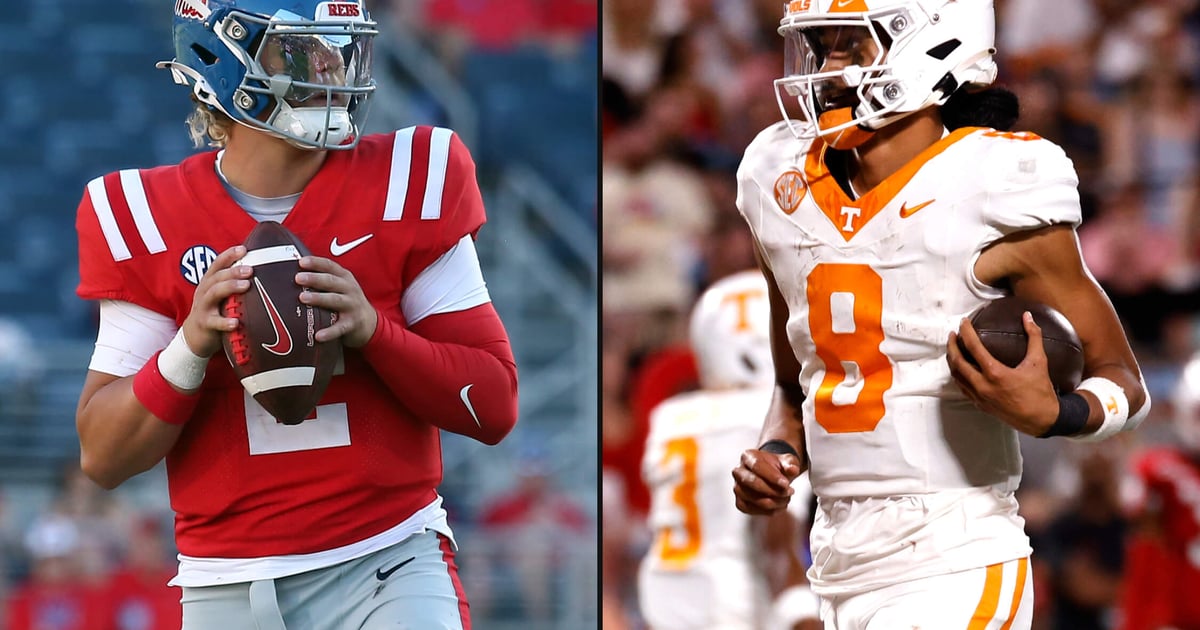What stat matters most in college football? Keep an eye on the explosive margin of play

They used to be called big plays. Or maybe long plays. It’s not clear when, or why, football people started calling them “explosive plays” or just “explosives.” It was probably around the same time that football people started calling position groups “rooms.”
Football people also can’t quite agree on what defines an explosive play, because there’s no official definition: Some use 15-yard runs and 20-yard passes. Others use less.
“People tend to skew them toward what’s best for them,” Georgia coach Kirby Smart said last year.
However, there is a growing consensus that one statistic is very important: Explosive play marginas who has more in a game is a key indicator of who wins the game. Maybe it always has been, maybe it means more in this era of higher scoring and more passing, meaning bend-but-don’t-break defenses prevail and ground-and-pound attacks do not.

Free daily sports updates straight to your inbox.
Free daily sports updates straight to your inbox.
To register
Georgia’s survival at Kentucky is a case in point: Kentucky outgained Georgia in yards, 284-262, and had a good running game in the second half. But in that decisive second half — defined as rushes of 12-plus yards and passes of 16-plus — Georgia had five explosive plays (three passing, two running) to Kentucky’s one, as Georgia’s defense gave up ground but stepped up when needed.

Georgia coach Kirby Smart, Carson Beck (15) outlasted Kentucky on Saturday with a 13-12 victory. (Carter Skaggs / Imagn Images)
That’s just one example from this season, where the data, as in previous seasons, continues to show that explosive margin is a key factor:
2024 (so far)
In SEC play (conference or non-conference), the team that wins the explosive margin has a record of 32-2.
The biggest exception is Arkansas, which was plus-15 in its overtime loss to Oklahoma State, with the Razorbacks blowing a huge lead and killing themselves with penalties (seven for 70 yards) and turnovers (minus-two). The other was Vanderbilt (nine explosives) in its five-point loss to Georgia State (eight explosives).
When the explosive margin is even or close, teams give themselves a chance. But the worse it gets, the harder it gets. Here’s a breakdown by margin, via TruMedia:
- +10 or better: 10-1
- +5 to +9: 13-0
- +1 to +4: 9-1
- Even: 1-2
- -1 to -4: 3-4
- -5 to -9: 0-3
- -10 or worse: 0-1
On a cumulative basis, the data is similar. There are three SEC teams with losing records, and those three rank in the bottom four in overall explosive game margin. The only SEC team with a negative differential and a winning record is LSU, which was -10 in its season-opener loss to USC but plus-five in its win over South Carolina.
SEC explosive plays per game
| Team | Explosives | Opponent’s explosives | Differential |
|---|---|---|---|
|
16.00 |
2.67 |
13.33 |
|
|
18.00 |
6.00 |
12.00 |
|
|
17.00 |
5.33 |
11.67 |
|
|
10.33 |
2.67 |
7.67 |
|
|
11.67 |
4.33 |
7.33 |
|
|
10.67 |
4.00 |
6.67 |
|
|
7.67 |
3.00 |
4.67 |
|
|
11.00 |
7.00 |
4.00 |
|
|
8.00 |
5.33 |
2.67 |
|
|
8.00 |
6.67 |
1.33 |
|
|
6.00 |
5.67 |
0.33 |
|
|
7.67 |
7.33 |
0.33 |
|
|
5.00 |
5.00 |
0.00 |
|
|
9.00 |
9.67 |
-0.67 |
|
|
8.33 |
9.33 |
-1.00 |
|
|
7.67 |
9.00 |
-1.33 |
Source: TruMedia
Recent Season History
From 2019-23, SEC teams that had more explosive plays than their opponent had an overall record of 397-72. And the higher the margin in that game, the more likely they were to win, according to TruMedia:
- +10 or better: 52-2 (.963)
- +5 to +9: 153-9 (.944)
- +1 to +4: 193-61 (.760)
- Even: 42-38 (.525)
- -1 to -4: 62-145 (.300)
- -5 to -9: 10-87 (.103)
- -10 or worse: 2-16 (.111)
(For relevance, four of the 12 losses by teams by a margin of five or more occurred during the 2020 COVID-19 season.)
On a cumulative basis, the five SEC champions — and six College Football Playoff participants, which means Georgia in 2021 — averaged 3.5 more explosive plays than their opponents. The four SEC teams that won the national title during that span averaged at least four more explosive plays than their opponents.
Does defense win championships? No, explosive margin does.
The reason for the data
Three-and-outs are great, but not necessary and much harder to come by than they used to be: According to TruMedia, the percentage of three-and-outs forced by SEC defenses has declined, from 35.5 percent of drives in 2004 to 31.5 percent in 2014 and 27.8 percent so far this year.
But defenses that force the offense to stay on the field longer, increasing the chance of mistakes, give themselves a better chance.
Georgia’s defense hasn’t given up a touchdown in the past four games, and in the season opener, Clemson was held to three or fewer plays on six of its 11 possessions. But on Saturday night, Kentucky had just one three-and-out among its 10 drives. The bigger deal was keeping the Wildcats from getting into the red zone on all but one of their possessions.
On the other side of the ball, offenses that get bigger chunk plays are reducing their chances of making mistakes. Time of possession has become much less meaningful as a result: Ole Miss (28 minutes, 55 seconds), Alabama (29:10) and Georgia (29:42) are all averaging less time of possession than their opponents thus far. Tennessee (30:48) and Texas (30:21) are barely above the line.
It’s an era of higher scoring, and coaches prefer points to long drives that only yield three points. Turnover margin still matters, as does field position and a few other traditional factors. But the explosive margin is the one that perhaps tells the story the most.
(Top photos of Jaxson Dart, left, and Nico Iamaleava: Petre Thomas/Imagn Images and Lance King/Getty Images)




